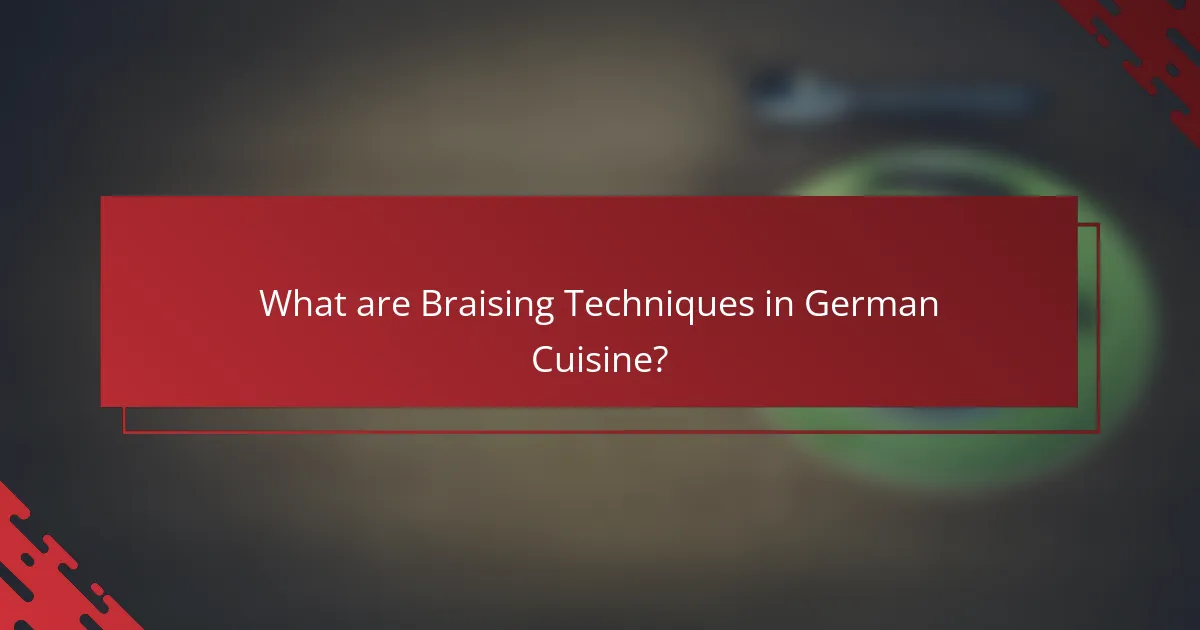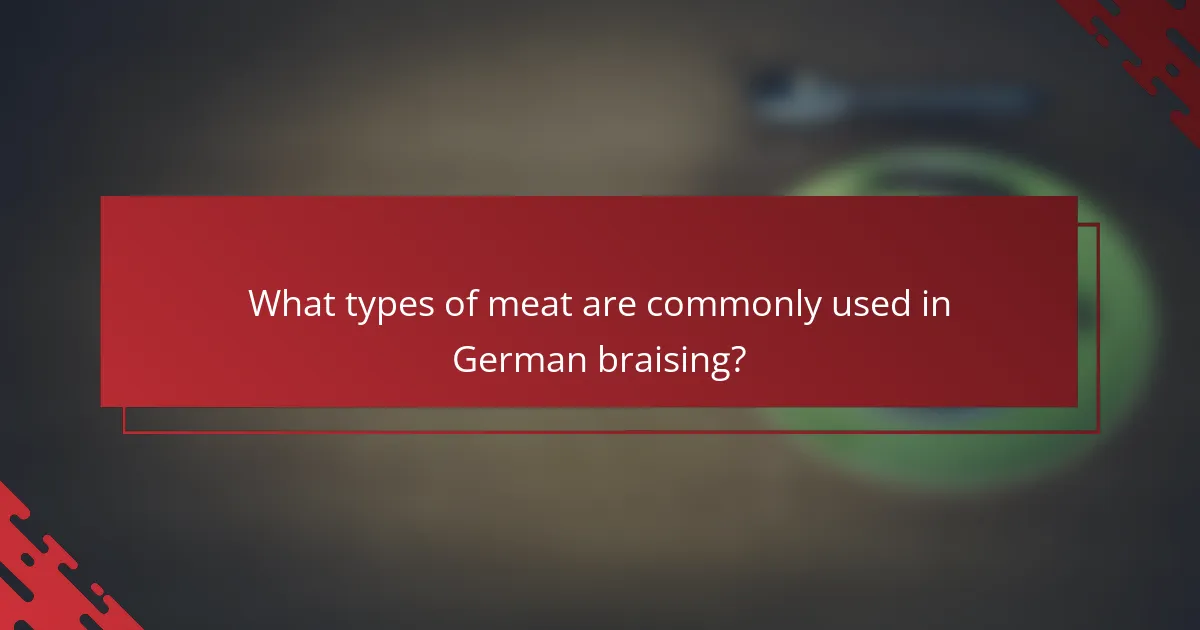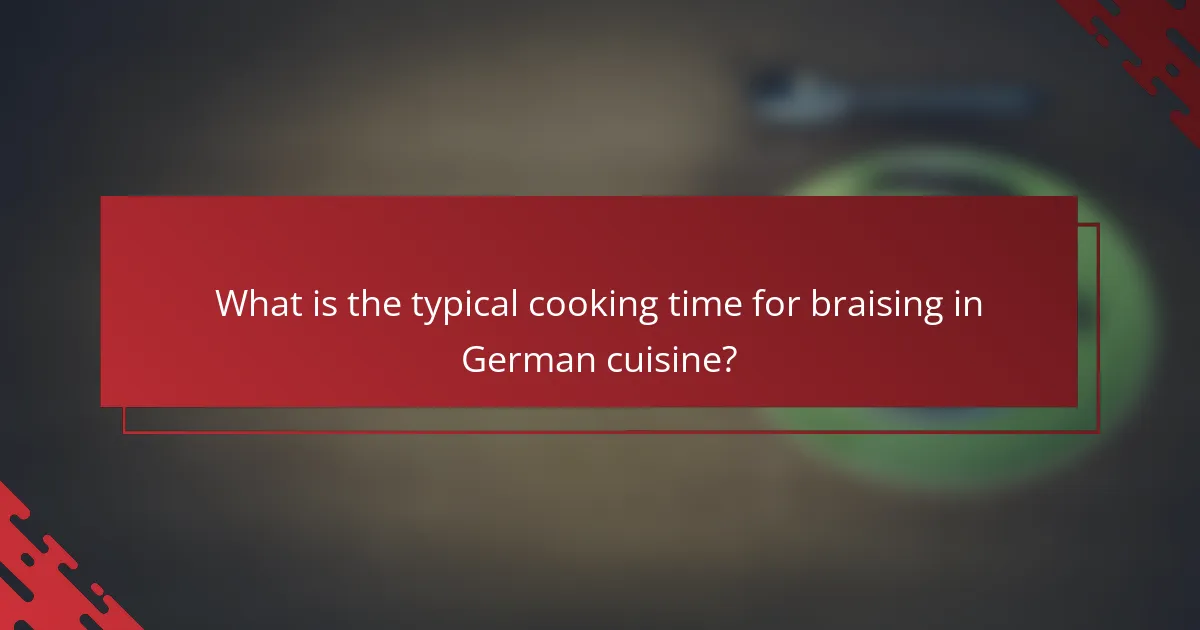Braising techniques in German cuisine involve the slow-cooking of meats such as pork, beef, and lamb in liquid over low heat, enhancing both flavor and tenderness. The process typically begins with searing the meat to create a rich crust, followed by simmering it in broth, wine, or beer, often accompanied by aromatic vegetables like onions, carrots, and celery. Cooking times for braising generally range from 1.5 to 4 hours, depending on the cut of meat, with tougher cuts requiring longer cooking to achieve optimal tenderness. Traditional German dishes, including Sauerbraten and Schmorbraten, exemplify these braising techniques and highlight the importance of specific meats in this culinary practice.

What are Braising Techniques in German Cuisine?
Braising techniques in German cuisine involve slow-cooking meat in liquid over low heat. This method enhances flavor and tenderness. Commonly used meats include pork, beef, and lamb. The process typically starts with searing the meat to develop a rich crust. After searing, the meat is simmered in broth, wine, or beer. Aromatic vegetables like onions, carrots, and celery are often added. The cooking time varies, generally ranging from two to four hours. Traditional dishes include Sauerbraten and Schmorbraten, showcasing these techniques effectively.
How does braising differ from other cooking methods?
Braising differs from other cooking methods by combining both dry and moist heat. This technique typically involves first searing the meat at a high temperature and then cooking it slowly in a covered pot with liquid. Unlike methods such as boiling or steaming, which primarily use moisture, braising relies on the initial browning to develop flavors. Additionally, braising is usually done at lower temperatures for extended periods, allowing tougher cuts of meat to become tender. This method is distinct from roasting, which uses dry heat without added liquid. The result is a dish that is flavorful and moist, showcasing the unique benefits of braising in culinary practices.
What are the key steps involved in the braising process?
The key steps involved in the braising process are searing, deglazing, adding liquid, and slow cooking. First, searing involves browning the meat in a hot pan with oil. This step develops flavor through the Maillard reaction. Next, deglazing occurs by adding a liquid, such as broth or wine, to the pan. This helps to lift the browned bits from the pan for added flavor. After deglazing, additional liquid is added to the pan to partially submerge the meat. This liquid is crucial for the braising process. Finally, slow cooking takes place, often in an oven or covered pot, at a low temperature for several hours. This step allows the meat to become tender and absorb the flavors of the liquid.
Why is braising particularly suited to German cuisine?
Braising is particularly suited to German cuisine due to its emphasis on hearty, flavorful dishes. German cuisine often features tough cuts of meat that benefit from slow cooking. This technique tenderizes the meat while enhancing its flavors. Traditional German dishes, such as Sauerbraten, exemplify this method. Braising allows for the incorporation of rich sauces, which are a hallmark of German cooking. The method also aligns with the use of seasonal vegetables commonly found in German recipes. Additionally, the long cooking times associated with braising fit the cultural preference for comfort food. Historical practices in Germany have favored this cooking style for centuries, demonstrating its deep-rooted significance in the cuisine.
What types of dishes typically utilize braising in German cooking?
German cooking typically utilizes braising in dishes such as Sauerbraten, Rinderroulade, and Schmorbraten. Sauerbraten is a pot roast, often made from beef, marinated before slow cooking. Rinderroulade consists of thinly sliced beef rolled with fillings, braised until tender. Schmorbraten refers to various cuts of meat braised in a flavorful liquid. These dishes showcase the technique’s ability to enhance flavors and tenderness. Braising is a traditional method in German cuisine, emphasizing hearty, comforting meals.
How do regional variations influence braising techniques?
Regional variations significantly influence braising techniques by adapting to local ingredients and cultural preferences. Different regions in Germany utilize various meats, such as pork in Bavaria and game in the Black Forest. The choice of liquid for braising, like beer in the north or wine in the south, varies based on local production. Cooking times also differ, with some areas favoring longer braising for tenderness. Additionally, regional spices and herbs, such as juniper berries in the north, enhance the flavor profile. These adaptations create distinct braising styles that reflect the culinary identity of each region.
What are some classic German braised dishes?
Classic German braised dishes include Sauerbraten, Rinderroulade, and Schweinebraten. Sauerbraten is a pot roast, typically made from beef, marinated in a mixture of vinegar and spices. Rinderroulade consists of thinly sliced beef rolled with bacon, onions, and pickles, then braised. Schweinebraten is a pork roast often seasoned with caraway seeds and cooked slowly for tenderness. These dishes are staples in German cuisine, showcasing the braising technique’s ability to enhance flavors and create rich, hearty meals.

What types of meat are commonly used in German braising?
Pork, beef, and lamb are commonly used in German braising. Pork shoulder is a popular choice for its tenderness and flavor. Beef chuck is favored for its rich taste and ability to become tender during cooking. Lamb shanks are also used, providing a unique flavor profile. These meats are often braised with vegetables and broth for enhanced taste. Traditional German dishes like Sauerbraten utilize these meats, showcasing their importance in the cuisine.
How does the choice of meat affect the flavor of the dish?
The choice of meat significantly influences the flavor of a dish. Different meats have unique flavor profiles due to their fat content, muscle fibers, and cooking properties. For example, beef typically offers a rich, robust flavor, while pork is often sweeter and more tender. Poultry, such as chicken, provides a milder taste that can absorb seasonings well. The method of cooking also impacts flavor; tougher cuts benefit from braising, which enhances their taste through slow cooking. Additionally, the quality and cut of meat can further differentiate flavors. For instance, marbled cuts have more fat, resulting in a juicier and more flavorful dish compared to lean cuts.
What are the most popular meats for braising in German cuisine?
The most popular meats for braising in German cuisine include beef, pork, and lamb. Beef is often used for dishes like Sauerbraten, which is marinated before braising. Pork, particularly cuts like shoulder or belly, is favored for its flavor and tenderness after slow cooking. Lamb is also a common choice, especially in regional dishes. These meats benefit from braising as the slow cooking process enhances their flavors and tenderness. Traditional German recipes emphasize the use of these meats to create hearty and flavorful dishes.
Why are certain cuts preferred for braising?
Certain cuts are preferred for braising because they contain more connective tissue and fat. These characteristics allow them to become tender and flavorful during the slow cooking process. Cuts such as chuck, brisket, and shanks are rich in collagen. When braised, collagen breaks down into gelatin, enhancing the dish’s richness. This method also helps to infuse flavors from spices and vegetables. The result is a moist and succulent final dish. Braising is particularly effective for tougher cuts that require longer cooking times to achieve tenderness.
What are the characteristics of meats best suited for braising?
Meats best suited for braising are typically tough cuts with high connective tissue content. These cuts include chuck, brisket, and shanks. They benefit from slow cooking methods that break down collagen into gelatin. This process enhances flavor and tenderness. Braising also requires meats that can absorb flavors from cooking liquids. The moisture from the braising liquid helps to soften the meat over time. Additionally, well-marbled meats provide richness during cooking. These characteristics make such meats ideal for braising techniques in German cuisine.
How does the fat content influence the braising outcome?
Fat content significantly influences the braising outcome. Higher fat content enhances moisture retention during cooking. This results in tender and flavorful meat. Fat also contributes to a richer sauce. The melting fat integrates with cooking liquids, improving overall taste. Additionally, fat helps in the even distribution of heat. This promotes consistent cooking and prevents drying out. Studies show that meats with higher fat content yield better braising results.
What role does the age of the meat play in the braising process?
The age of the meat significantly affects the braising process. Older meat typically has more connective tissue, which breaks down during slow cooking. This breakdown enhances tenderness and flavor in the final dish. Conversely, younger meat may require less cooking time due to its lower connective tissue content. Proper braising of older meat can yield a rich, savory result. Research indicates that aging meat can improve its flavor profile due to enzymatic activity. This enzymatic process enhances the meat’s overall taste and texture, making it ideal for braising.

What is the typical cooking time for braising in German cuisine?
The typical cooking time for braising in German cuisine is between 1.5 to 3 hours. This duration depends on the type and cut of meat used. For tougher cuts, such as beef chuck or pork shoulder, longer cooking times are required. These cuts benefit from extended heat to become tender. The cooking process often involves simmering in liquid, which helps to infuse flavors. Generally, a low and slow approach is preferred in traditional German braising. This technique ensures the meat becomes flavorful and tender.
How does cooking time vary by type of meat?
Cooking time varies significantly by type of meat. For example, beef typically requires longer cooking times than poultry. Beef cuts like brisket may take 3 to 4 hours to braise, while chicken breasts usually require about 1 to 1.5 hours. Pork, depending on the cut, often takes 2 to 3 hours for effective braising. Lamb shanks generally need around 2 to 3 hours as well. Ground meats cook much faster, often in less than an hour. These variations are influenced by factors such as meat density and fat content. Braising methods, which involve cooking in liquid at low temperatures, enhance tenderness in tougher cuts.
What are the general time guidelines for braising different meats?
Braising times vary depending on the type of meat. Generally, tougher cuts of meat require longer cooking times. For beef, braising usually takes 2.5 to 3 hours. Pork typically requires about 2 to 3 hours as well. Lamb often needs 1.5 to 2 hours for optimal tenderness. Chicken can be braised in about 1 to 1.5 hours. These times ensure that the meat becomes tender and flavorful. The cooking method involves low, slow heat which breaks down connective tissues effectively.
How can one determine when braised meat is done?
Braised meat is done when it reaches a tender texture and an internal temperature of at least 145°F (63°C). This temperature ensures that the meat is safe to eat. To check for doneness, insert a meat thermometer into the thickest part of the meat. Additionally, the meat should easily pull apart with a fork. The braising liquid should be reduced and thickened, indicating that the cooking process is complete. These indicators confirm that the braising method has effectively tenderized the meat.
What factors can influence the cooking time in braising?
The cooking time in braising can be influenced by several factors. The type of meat is a primary factor; tougher cuts require longer cooking times. The size and thickness of the meat pieces also play a significant role; larger pieces take more time to become tender. The cooking temperature affects the duration; lower temperatures generally require longer braising. The amount of liquid used can impact cooking time; more liquid can lead to longer braising. Additionally, the presence of bones can shorten cooking time, as they conduct heat more efficiently. Finally, the cooking vessel’s material and shape can influence heat distribution and cooking duration.
How do different braising liquids affect cooking time?
Different braising liquids can significantly affect cooking time. The acidity level in liquids like wine or vinegar can tenderize meat faster. This is due to the breakdown of proteins in the meat. In contrast, thicker liquids, such as sauces, may require longer cooking times. They can create a barrier that slows heat [censured]. For example, a broth-based liquid typically cooks meat more quickly than a cream-based sauce. Additionally, the temperature of the liquid at the start can influence cooking duration. Hot liquids reduce overall cooking time compared to cold ones.
What is the impact of pot size and heat source on braising time?
Pot size and heat source significantly impact braising time. A larger pot allows for more even heat distribution and can accommodate larger cuts of meat. This may result in longer braising times due to the increased volume of liquid and surface area. Conversely, a smaller pot may lead to quicker braising times as the heat concentrates more effectively on smaller cuts. The heat source also plays a crucial role. Gas heat provides quicker temperature adjustments compared to electric heat. This can affect the overall cooking duration, with gas often resulting in shorter braising times. A study from the Culinary Institute of America indicates that pot size and heat source can alter cooking efficiency by up to 30%.
What are some tips for successful braising in German cuisine?
Successful braising in German cuisine involves a few key techniques. Start by selecting the right cut of meat, such as beef chuck or pork shoulder. These cuts have enough fat and connective tissue to become tender during cooking. Sear the meat first in a hot pan to develop a rich, brown crust. This enhances the flavor through the Maillard reaction.
Next, add aromatic vegetables like onions, carrots, and celery. These will infuse the dish with depth. Pour in a braising liquid, which can include broth, wine, or beer. Each adds distinct flavors characteristic of German cuisine.
Cover the pot tightly to retain moisture and heat. Braise the meat at a low temperature, typically around 300°F (150°C), for several hours. This slow cooking process allows the meat to break down and become tender.
Finally, check for doneness by testing the meat’s tenderness. It should easily pull apart with a fork. This method ensures a successful braising experience, yielding a flavorful and tender dish.
Braising techniques in German cuisine involve slow-cooking meats such as pork, beef, and lamb in liquid over low heat, enhancing flavor and tenderness. Key steps include searing the meat, deglazing, adding liquid, and slow cooking, typically for two to four hours. This method is well-suited to German cooking due to its emphasis on hearty dishes and the use of tougher cuts of meat that benefit from extended cooking times. The article also explores the impact of meat choice, cooking time, and regional variations on braising, along with tips for successful execution of this technique.